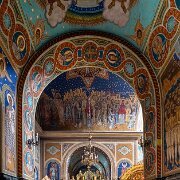
7 The Metropolitan Cathedral of Christ’s Nativity, located in Chișinău, Moldova, is the main Orthodox cathedral of the country and serves as a significant religious and cultural landmark. Built in 1830 under the direction of architect Avraam Melnikov, the cathedral was commissioned by Prince Mikhail Semyonovich Vorontsov, then Governor of Bessarabia. It was designed as part of a broader effort to establish Orthodox Christian influence in the region, which was then under the Russian Empire’s control. Over the years, the cathedral has witnessed various historical changes, including damage during World War II and suppression of religious activities during the Soviet era when it was repurposed as an exhibition hall. After Moldova’s independence in 1991, the cathedral was restored to its original purpose and remains a central place of worship for Orthodox Christians in the country.
Architecturally, the cathedral is a prime example of Neoclassical design, characterized by its symmetry, simplicity, and grandeur. Its exterior features a large central dome, symbolizing the heavens, supported by a rectangular base. The entrance is marked by a prominent portico with six Ionic columns, giving it a stately and elegant appearance. The cathedral's bell tower, originally built separately from the main structure, was destroyed during World War II but was reconstructed in the early 2000s to restore the integrity of the original layout. Inside, the cathedral is adorned with frescoes, chandeliers, and a richly decorated iconostasis, reflecting traditional Orthodox Christian artistic influences.
Architecturally, the cathedral is a prime example of Neoclassical design, characterized by its symmetry, simplicity, and grandeur. Its exterior features a large central dome, symbolizing the heavens, supported by a rectangular base. The entrance is marked by a prominent portico with six Ionic columns, giving it a stately and elegant appearance. The cathedral's bell tower, originally built separately from the main structure, was destroyed during World War II but was reconstructed in the early 2000s to restore the integrity of the original layout. Inside, the cathedral is adorned with frescoes, chandeliers, and a richly decorated iconostasis, reflecting traditional Orthodox Christian artistic influences.
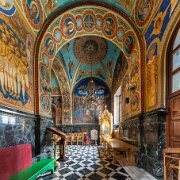
8 The Metropolitan Cathedral of Christ’s Nativity, located in Chișinău, Moldova, is the main Orthodox cathedral of the country and serves as a significant religious and cultural landmark. Built in 1830 under the direction of architect Avraam Melnikov, the cathedral was commissioned by Prince Mikhail Semyonovich Vorontsov, then Governor of Bessarabia. It was designed as part of a broader effort to establish Orthodox Christian influence in the region, which was then under the Russian Empire’s control. Over the years, the cathedral has witnessed various historical changes, including damage during World War II and suppression of religious activities during the Soviet era when it was repurposed as an exhibition hall. After Moldova’s independence in 1991, the cathedral was restored to its original purpose and remains a central place of worship for Orthodox Christians in the country.
Architecturally, the cathedral is a prime example of Neoclassical design, characterized by its symmetry, simplicity, and grandeur. Its exterior features a large central dome, symbolizing the heavens, supported by a rectangular base. The entrance is marked by a prominent portico with six Ionic columns, giving it a stately and elegant appearance. The cathedral's bell tower, originally built separately from the main structure, was destroyed during World War II but was reconstructed in the early 2000s to restore the integrity of the original layout. Inside, the cathedral is adorned with frescoes, chandeliers, and a richly decorated iconostasis, reflecting traditional Orthodox Christian artistic influences.
Architecturally, the cathedral is a prime example of Neoclassical design, characterized by its symmetry, simplicity, and grandeur. Its exterior features a large central dome, symbolizing the heavens, supported by a rectangular base. The entrance is marked by a prominent portico with six Ionic columns, giving it a stately and elegant appearance. The cathedral's bell tower, originally built separately from the main structure, was destroyed during World War II but was reconstructed in the early 2000s to restore the integrity of the original layout. Inside, the cathedral is adorned with frescoes, chandeliers, and a richly decorated iconostasis, reflecting traditional Orthodox Christian artistic influences.
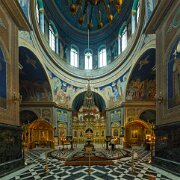
9 The Metropolitan Cathedral of Christ’s Nativity, located in Chișinău, Moldova, is the main Orthodox cathedral of the country and serves as a significant religious and cultural landmark. Built in 1830 under the direction of architect Avraam Melnikov, the cathedral was commissioned by Prince Mikhail Semyonovich Vorontsov, then Governor of Bessarabia. It was designed as part of a broader effort to establish Orthodox Christian influence in the region, which was then under the Russian Empire’s control. Over the years, the cathedral has witnessed various historical changes, including damage during World War II and suppression of religious activities during the Soviet era when it was repurposed as an exhibition hall. After Moldova’s independence in 1991, the cathedral was restored to its original purpose and remains a central place of worship for Orthodox Christians in the country.
Architecturally, the cathedral is a prime example of Neoclassical design, characterized by its symmetry, simplicity, and grandeur. Its exterior features a large central dome, symbolizing the heavens, supported by a rectangular base. The entrance is marked by a prominent portico with six Ionic columns, giving it a stately and elegant appearance. The cathedral's bell tower, originally built separately from the main structure, was destroyed during World War II but was reconstructed in the early 2000s to restore the integrity of the original layout. Inside, the cathedral is adorned with frescoes, chandeliers, and a richly decorated iconostasis, reflecting traditional Orthodox Christian artistic influences.
Architecturally, the cathedral is a prime example of Neoclassical design, characterized by its symmetry, simplicity, and grandeur. Its exterior features a large central dome, symbolizing the heavens, supported by a rectangular base. The entrance is marked by a prominent portico with six Ionic columns, giving it a stately and elegant appearance. The cathedral's bell tower, originally built separately from the main structure, was destroyed during World War II but was reconstructed in the early 2000s to restore the integrity of the original layout. Inside, the cathedral is adorned with frescoes, chandeliers, and a richly decorated iconostasis, reflecting traditional Orthodox Christian artistic influences.

10 The Metropolitan Cathedral of Christ’s Nativity, located in Chișinău, Moldova, is the main Orthodox cathedral of the country and serves as a significant religious and cultural landmark. Built in 1830 under the direction of architect Avraam Melnikov, the cathedral was commissioned by Prince Mikhail Semyonovich Vorontsov, then Governor of Bessarabia. It was designed as part of a broader effort to establish Orthodox Christian influence in the region, which was then under the Russian Empire’s control. Over the years, the cathedral has witnessed various historical changes, including damage during World War II and suppression of religious activities during the Soviet era when it was repurposed as an exhibition hall. After Moldova’s independence in 1991, the cathedral was restored to its original purpose and remains a central place of worship for Orthodox Christians in the country.
Architecturally, the cathedral is a prime example of Neoclassical design, characterized by its symmetry, simplicity, and grandeur. Its exterior features a large central dome, symbolizing the heavens, supported by a rectangular base. The entrance is marked by a prominent portico with six Ionic columns, giving it a stately and elegant appearance. The cathedral's bell tower, originally built separately from the main structure, was destroyed during World War II but was reconstructed in the early 2000s to restore the integrity of the original layout. Inside, the cathedral is adorned with frescoes, chandeliers, and a richly decorated iconostasis, reflecting traditional Orthodox Christian artistic influences.
Architecturally, the cathedral is a prime example of Neoclassical design, characterized by its symmetry, simplicity, and grandeur. Its exterior features a large central dome, symbolizing the heavens, supported by a rectangular base. The entrance is marked by a prominent portico with six Ionic columns, giving it a stately and elegant appearance. The cathedral's bell tower, originally built separately from the main structure, was destroyed during World War II but was reconstructed in the early 2000s to restore the integrity of the original layout. Inside, the cathedral is adorned with frescoes, chandeliers, and a richly decorated iconostasis, reflecting traditional Orthodox Christian artistic influences.
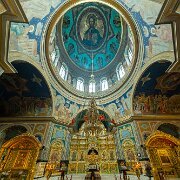
11 The Metropolitan Cathedral of Christ’s Nativity, located in Chișinău, Moldova, is the main Orthodox cathedral of the country and serves as a significant religious and cultural landmark. Built in 1830 under the direction of architect Avraam Melnikov, the cathedral was commissioned by Prince Mikhail Semyonovich Vorontsov, then Governor of Bessarabia. It was designed as part of a broader effort to establish Orthodox Christian influence in the region, which was then under the Russian Empire’s control. Over the years, the cathedral has witnessed various historical changes, including damage during World War II and suppression of religious activities during the Soviet era when it was repurposed as an exhibition hall. After Moldova’s independence in 1991, the cathedral was restored to its original purpose and remains a central place of worship for Orthodox Christians in the country.
Architecturally, the cathedral is a prime example of Neoclassical design, characterized by its symmetry, simplicity, and grandeur. Its exterior features a large central dome, symbolizing the heavens, supported by a rectangular base. The entrance is marked by a prominent portico with six Ionic columns, giving it a stately and elegant appearance. The cathedral's bell tower, originally built separately from the main structure, was destroyed during World War II but was reconstructed in the early 2000s to restore the integrity of the original layout. Inside, the cathedral is adorned with frescoes, chandeliers, and a richly decorated iconostasis, reflecting traditional Orthodox Christian artistic influences.
Architecturally, the cathedral is a prime example of Neoclassical design, characterized by its symmetry, simplicity, and grandeur. Its exterior features a large central dome, symbolizing the heavens, supported by a rectangular base. The entrance is marked by a prominent portico with six Ionic columns, giving it a stately and elegant appearance. The cathedral's bell tower, originally built separately from the main structure, was destroyed during World War II but was reconstructed in the early 2000s to restore the integrity of the original layout. Inside, the cathedral is adorned with frescoes, chandeliers, and a richly decorated iconostasis, reflecting traditional Orthodox Christian artistic influences.

12 The Metropolitan Cathedral of Christ’s Nativity, located in Chișinău, Moldova, is the main Orthodox cathedral of the country and serves as a significant religious and cultural landmark. Built in 1830 under the direction of architect Avraam Melnikov, the cathedral was commissioned by Prince Mikhail Semyonovich Vorontsov, then Governor of Bessarabia. It was designed as part of a broader effort to establish Orthodox Christian influence in the region, which was then under the Russian Empire’s control. Over the years, the cathedral has witnessed various historical changes, including damage during World War II and suppression of religious activities during the Soviet era when it was repurposed as an exhibition hall. After Moldova’s independence in 1991, the cathedral was restored to its original purpose and remains a central place of worship for Orthodox Christians in the country.
Architecturally, the cathedral is a prime example of Neoclassical design, characterized by its symmetry, simplicity, and grandeur. Its exterior features a large central dome, symbolizing the heavens, supported by a rectangular base. The entrance is marked by a prominent portico with six Ionic columns, giving it a stately and elegant appearance. The cathedral's bell tower, originally built separately from the main structure, was destroyed during World War II but was reconstructed in the early 2000s to restore the integrity of the original layout. Inside, the cathedral is adorned with frescoes, chandeliers, and a richly decorated iconostasis, reflecting traditional Orthodox Christian artistic influences.
Architecturally, the cathedral is a prime example of Neoclassical design, characterized by its symmetry, simplicity, and grandeur. Its exterior features a large central dome, symbolizing the heavens, supported by a rectangular base. The entrance is marked by a prominent portico with six Ionic columns, giving it a stately and elegant appearance. The cathedral's bell tower, originally built separately from the main structure, was destroyed during World War II but was reconstructed in the early 2000s to restore the integrity of the original layout. Inside, the cathedral is adorned with frescoes, chandeliers, and a richly decorated iconostasis, reflecting traditional Orthodox Christian artistic influences.
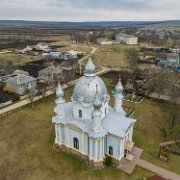
13 The Biserica Cubolta, located in the village of Cubolta, Moldova, is an important historical and religious site with deep roots in the region’s Orthodox Christian tradition. Built in the 19th century during the period of the Russian Empire’s rule over Bessarabia, the church served as a central place of worship for the local community. Like many other religious structures in Moldova, Biserica Cubolta faced hardships during the Soviet era, when religious practices were suppressed, and many churches were either repurposed or left in disrepair. Despite these challenges, the church has remained a symbol of spiritual endurance and has undergone restoration efforts to preserve its historical and cultural significance.
Architecturally, Biserica Cubolta showcases a blend of traditional Moldovan ecclesiastical design with influences from Russian Orthodox architecture. The church is characterized by a central dome, often a defining feature of Orthodox churches, which symbolizes the heavens and serves as a focal point of worship. Its façade is adorned with decorative elements that highlight the craftsmanship of the time, including intricate stone or brickwork. The interior features frescoes, icons, and an iconostasis, all reflecting the rich artistic heritage of Eastern Orthodox Christianity.
Architecturally, Biserica Cubolta showcases a blend of traditional Moldovan ecclesiastical design with influences from Russian Orthodox architecture. The church is characterized by a central dome, often a defining feature of Orthodox churches, which symbolizes the heavens and serves as a focal point of worship. Its façade is adorned with decorative elements that highlight the craftsmanship of the time, including intricate stone or brickwork. The interior features frescoes, icons, and an iconostasis, all reflecting the rich artistic heritage of Eastern Orthodox Christianity.
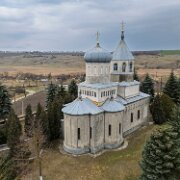
14 Biserica de lemn „Adormirea Maicii Domnului” is a historic wooden church located in the village of Măcăreuca, Drochia district, Republic of Moldova. First mentioned in 1793, the church has stood as a testament to the village's rich cultural and religious heritage. Over the centuries, it has withstood various challenges, including two world wars, serving as a central place of worship and community gatherings for the local populace. However, in recent decades, the church has fallen into disrepair, with no religious services held for over 20 years, leading to concerns about its structural integrity and preservation.
Architecturally, the church exemplifies traditional Moldovan wooden ecclesiastical design. Its construction features wooden walls and a thatched roof, characteristic of the era and region. The interior, though now deteriorating, once boasted intricate woodwork and religious iconography that reflected the craftsmanship of local artisans. Despite its current dilapidated state, the church remains a symbol of historical significance. Efforts have been called for to restore and preserve this monument, recognizing its value as part of Moldova's national heritage.
Architecturally, the church exemplifies traditional Moldovan wooden ecclesiastical design. Its construction features wooden walls and a thatched roof, characteristic of the era and region. The interior, though now deteriorating, once boasted intricate woodwork and religious iconography that reflected the craftsmanship of local artisans. Despite its current dilapidated state, the church remains a symbol of historical significance. Efforts have been called for to restore and preserve this monument, recognizing its value as part of Moldova's national heritage.
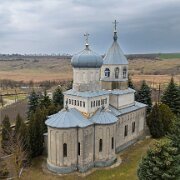
15 Biserica de lemn „Adormirea Maicii Domnului” is a historic wooden church located in the village of Măcăreuca, Drochia district, Republic of Moldova. First mentioned in 1793, the church has stood as a testament to the village's rich cultural and religious heritage. Over the centuries, it has withstood various challenges, including two world wars, serving as a central place of worship and community gatherings for the local populace. However, in recent decades, the church has fallen into disrepair, with no religious services held for over 20 years, leading to concerns about its structural integrity and preservation.
Architecturally, the church exemplifies traditional Moldovan wooden ecclesiastical design. Its construction features wooden walls and a thatched roof, characteristic of the era and region. The interior, though now deteriorating, once boasted intricate woodwork and religious iconography that reflected the craftsmanship of local artisans. Despite its current dilapidated state, the church remains a symbol of historical significance. Efforts have been called for to restore and preserve this monument, recognizing its value as part of Moldova's national heritage.
Architecturally, the church exemplifies traditional Moldovan wooden ecclesiastical design. Its construction features wooden walls and a thatched roof, characteristic of the era and region. The interior, though now deteriorating, once boasted intricate woodwork and religious iconography that reflected the craftsmanship of local artisans. Despite its current dilapidated state, the church remains a symbol of historical significance. Efforts have been called for to restore and preserve this monument, recognizing its value as part of Moldova's national heritage.








Churches